As usual, when it comes to ancient inventions, there is debate
as to who was first to design scissors. Apparently shears
showed up between 100-300BC in Mesopatamia and Egypt
and Italy and probably wherever there were sheep. Not long
after the first shears were introduced, smaller versions of scissors (a
word we derive from the Latin for cutting – cisorium) appeared.
Hence the Italians win, at least as far as the dictionary is concerned.
Thereafter, advances in metals and improvement of the pivot (or hinge)
connecting the blades were the primary advances in scissor design.
Today the variety of scissors is mind boggling and difficult for a fly tyer
to decipher.
PHYSICS OF SCISSORING:
Technically, scissors use the
hinge as a fulcrum to provide the mechanical advantage of a lever for cutting.
The further away from the fulcrum your fingers are and the closer to the
fulcrum what you are cutting is, the greater mechanical advantage you gain
over whatever is being cut near the fulcrum. (That's why many scissors
with the hinge spaced evenly between finger holes and blade tip don't cut
very well near the tip.) To make things easier for use in the human hand,
the scissors blade held by the thumb (the upper shear blade) is designed
to overcome lateral forces generated in closing a human hand. The blades
on right-handed scissors are set so that, whichever way up you hold them,
the right blade is always on top. This means that the cutting action of the
right hand pushes the blades together to give a smooth cut the whole length
of the blades and also that a right-hander has a clear view of the cutting line.
When a left-hander uses right-handed scissors, he has to push the thumb
and index finger together in an unnatural way to make the scissors cut and
must look over the top blade, which obscures the cutting line. Right-handed
scissors mean just that, and trying to cut left-handed with right-handed scissors
will often produce less than satisfactory results.
WHAT MAKES GOOD FLY TYING SCISSORS?
Modern scissors can be found in hundreds of shapes, sizes and designs,
not all of which are suitable for fly tying. Fly tyers are as demanding as
scissors buyers get and most have a love-hate relationship with their tools.
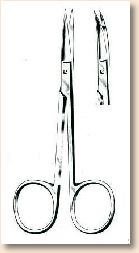 General fly tying related scissor types include: (1) rounded (children's style);
(2) serrated-blade (minute ridges on the blade for cutting difficult items like
leather), (3) ceramic blade (never needs sharpening), (4) surgical style
(medium width blade, pointed but not necessarily fine), (5) fine-point,
(6) curved-blade (may have fine point); and (6) spring-type (squeeze
to cut release to open). The sharpness of scissors is determined by the
alignment and finish of the blades. Objects being cut want to force the
scissor blades apart so designers have the blades draw (they are bent
slightly against each other) and turn (slightly twist). Consequently, quality
scissors sit together tightly from the point to the joint area when closed.
Be wary of scissors with an adjustable screw (the "stud") at the hinge.
A good stud never needs adjustment. If the screw is tightened, they
may become sharper but also stiffer to close. If the screw is loosened,
sharpness is reduced and the scissors may loss their run and seem to
wiggle. The "run" is the smooth feel you get when you cut. A good run
produces an even, clean cut for the full length of the blade without hesitation
or roughness. The blades must remain in contact when the scissors are closed
but, when cutting and closing, they should only touch each other at one point.
General fly tying related scissor types include: (1) rounded (children's style);
(2) serrated-blade (minute ridges on the blade for cutting difficult items like
leather), (3) ceramic blade (never needs sharpening), (4) surgical style
(medium width blade, pointed but not necessarily fine), (5) fine-point,
(6) curved-blade (may have fine point); and (6) spring-type (squeeze
to cut release to open). The sharpness of scissors is determined by the
alignment and finish of the blades. Objects being cut want to force the
scissor blades apart so designers have the blades draw (they are bent
slightly against each other) and turn (slightly twist). Consequently, quality
scissors sit together tightly from the point to the joint area when closed.
Be wary of scissors with an adjustable screw (the "stud") at the hinge.
A good stud never needs adjustment. If the screw is tightened, they
may become sharper but also stiffer to close. If the screw is loosened,
sharpness is reduced and the scissors may loss their run and seem to
wiggle. The "run" is the smooth feel you get when you cut. A good run
produces an even, clean cut for the full length of the blade without hesitation
or roughness. The blades must remain in contact when the scissors are closed
but, when cutting and closing, they should only touch each other at one point.
SELECTING FLY TYING SCISSORS:
For fly tying, items to be cut include the finest hackle to the densest hair
from a hoofed animal's winter coat. Cuts may be measured in microns
or inches and each one can spell success or disaster for the fly. All tyers
know the misery of an innocent nip on a dangling piece of material that
suddenly bisects the critical tying thread, causing the entire fly to unravel
and a meticulously assembled nymph masterpiece looks like a hair ball
a cat coughed up on the vise. At that point the tyer needs someone to
blame, and why not blame the scissors? Inevitably this leads to
abandonment and divorce. I have a drawer full of ex-best scissors.
The predominant scissor manufacturer for fly tyers is Dr. Slick (www.drslick.com).
Dr. Slick does not sell directly to the public but can be found in most fly tying
equipment catalogs (e.g. www.cabelas.com, https://www.theflyshop.com ,
www.dan-bailey.com, https://feather-craft.com). In 2004 I inherited scissors
from my father, the surgeon. They are hospital quality tools called "iris" scissors
and look like the pair in the drawing (with the curved blades). With short very
sharp blades near the fulcrum and the finger holes several inches away, they
have great cutting leverage but the fine point can still handle very delicate cuts.
Go to any Internet search engine (e.g. https://clusty.com), put in "iris scissors"
and you will get several sites that offer 4.5" iris scissors from as little as $2.49/pair.
Dr. Slick actually has nice iris scissors, and for those I again prefer the curved
blades.
Look at finer tools made with a higher class of steel, and you will note
that the price increases rapidly. Considering how excellent my father's
scissors are, you might want to look for surgical tools at Robbins
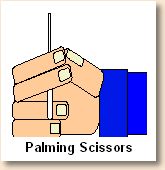 Instruments https://www.robbinsinstruments.com/scissors/iris.html and you
will find iris scissors for $35. Iris scissors come with flat or curved blades,
which is a matter of the tyer's preference. The pair I inherited are curved
and 6" long rather than 4.5" and I have found a similar scissor called "kelly's
scissors" at https://www.bluelakeproducts.com/scissors_kellys.htm which
run $5/pair. You may prefer the smaller version, but then again, many things
may affect a tyer's preference.
Instruments https://www.robbinsinstruments.com/scissors/iris.html and you
will find iris scissors for $35. Iris scissors come with flat or curved blades,
which is a matter of the tyer's preference. The pair I inherited are curved
and 6" long rather than 4.5" and I have found a similar scissor called "kelly's
scissors" at https://www.bluelakeproducts.com/scissors_kellys.htm which
run $5/pair. You may prefer the smaller version, but then again, many things
may affect a tyer's preference.
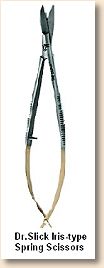 SCISSORING OPTIONS: Here are a few things to look for
in scissors, but remember that every pair of scissors will have a certain
"feel" which may differ for each fly tyer. The "rightness" or "wrongness"
of feel can be dependent upon any of the items below.
SCISSORING OPTIONS: Here are a few things to look for
in scissors, but remember that every pair of scissors will have a certain
"feel" which may differ for each fly tyer. The "rightness" or "wrongness"
of feel can be dependent upon any of the items below.
1. Finger holes (called "eyes") come in oval, round or open loop.
Many production tyers constantly hold their scissors in their palm.
Consequently, "fly tying" scissors are designed with large eyes so
the scissors be held deep in the palm while other tying activities
are taking place. Without large eyes this technique is painful, usually
not possible, but even with the right scissors, this technique takes
practice and getting used to the unusual feel. Spring (or "squeeze")
scissors are intended to be held in the palm at all times. [Note: when
buying spring scissors you should insure that they have a smooth run
and spring back sharply, without hesitation.]
2. Weight. Scissors should be balanced and light enough to
allow the tyer to move them around the fly small fractions of
an inch without effort. Few of us have the steady hands of a
surgeon and many scissors feel "butt heavy" or simply don't
move into position as easily as a tyer would like. This is generally
a weight or balance issue. Curiously, while tiny cosmetic scissors
can feel almost weightless, a little weight may actually allow the tyer
to hold the scissors steadier. Steel scissors obviously weigh more
than aluminum scissors.
3. Overall Length. Functional scissors range from 3 inches to
10 inches from tip to butt. Some tyers choose small scissors
because they feel they have more control if their fingers are right
up to the fly as they are cutting (if the scissors are deep in your
palm you have no other choice). Occasionally, however, fingers
can obscure vision of what you are cutting or the lack of length
will seriously effect the cutting strength. Longer scissors may
provide a better view of the work area and also afford the
opportunity to steady the scissors along their shank with your
non-cutting hand.
4. Blade style/length: The longer the blade the less leverage
advantage the tyer has toward the tip of the blade. As most
fly tying cutting does not involve long straight cuts, shorter blades
are almost always better. For cutting strips of material (i.e. fun
foam) longer blades are preferable and curved blades will not
work well at all.
5. Quality of the closure. Open and close new scissors before
buying to insure a smooth run. Any hesitation or rough feel is
not a good sign. The tips of good quality scissors always meet
perfectly in closed position and will cut along the entire length
of the cutting edge to the tip. Don't buy scissors that have
overlapping tips. This is a sign of the maker compensating for
poor quality. Look at the scissors sideways before buying and
make sure no light shows through along the entire line where the
blades meet.
6. Fine tip. Tying scissors should have a tip that comes to a fine
point. "Fine" is relative depending on the size of the scissor blades,
but generally the tip should be able to selectively cut a single barb
on a hackle.
7. Different textures, different scissors. Some edges are simply
better for cutting certain materials. Serrated blades make short
work of thick hair and tend to squeeze the hair less toward the
tip when cutting. Long blades are better for cutting sheets of materials
(i.e. fun foam), fine points are needed for trimming, and some tyers
simply prefer curved to straight blades. Owning a single pair of
scissors is putting the tyer at a disadvantage that current discount
prices do not warrant.
WHERE TO BUY SCISSORS:
As noted above, the usual suspects carry scissors (Cabelas, Feather
Craft, etc.) You may want to look at https://www.drslick.com. This
is the Dr. Slick web site and many varieties of fly tying scissors are
shown (I am divorced from some of these).
Like your Mom couldn't tell you what girls to date, I can't what scissors
to buy. I'll just sort of point you in the right direction and hope for the best.
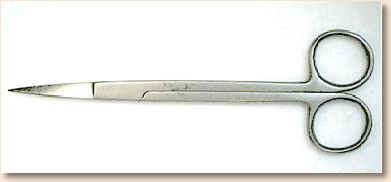 ~ Bob
~ Bob
About Bob:
Robert Lamar Boese has fly fished for five decades. He is an
environmental negotiator, attorney and educator who has provided
environmental legal services for more than thirty-three years including
active duty with the U.S. Coast Guard and Department of Justice. He is a
well known fly tyer with several unique patterns to his credit. He has
developed and authored federal and state regulatory programs
encompassing a broad spectrum of environmental disciplines, has
litigated environmental matters at all levels of the federal and state
court systems, and is a qualified expert for testimony in environmental
law. He has authored over 60 published text chapters, comments or
articles on environmental matters, is a member of the Colorado, District
of Columbia and Louisiana Bar Associations, and is a certified mediator.
In addition to his legal practice, Mr. Boese has been a high school
teacher, an associate professor of Environmental Law and Public Health,
has authored numerous fiction and sports publications, and is a softball
coach and nationally certified volleyball referee. He is the president
of the Acadiana Fly Rodders in Lafayette, Louisiana and editor of
Acadiana on the Fly. He has been married for thirty years and is the
father of two fly fishing girls (25 and 21). For additional information
contact: Boese Environmental Law, 103 Riviera Court, Broussard, LA 70518
or call 337.856.7890 or email coachbob@ymail.com.
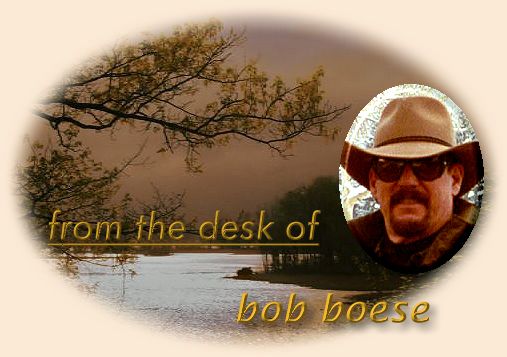


 General fly tying related scissor types include: (1) rounded (children's style);
(2) serrated-blade (minute ridges on the blade for cutting difficult items like
leather), (3) ceramic blade (never needs sharpening), (4) surgical style
(medium width blade, pointed but not necessarily fine), (5) fine-point,
(6) curved-blade (may have fine point); and (6) spring-type (squeeze
to cut release to open). The sharpness of scissors is determined by the
alignment and finish of the blades. Objects being cut want to force the
scissor blades apart so designers have the blades draw (they are bent
slightly against each other) and turn (slightly twist). Consequently, quality
scissors sit together tightly from the point to the joint area when closed.
Be wary of scissors with an adjustable screw (the "stud") at the hinge.
A good stud never needs adjustment. If the screw is tightened, they
may become sharper but also stiffer to close. If the screw is loosened,
sharpness is reduced and the scissors may loss their run and seem to
wiggle. The "run" is the smooth feel you get when you cut. A good run
produces an even, clean cut for the full length of the blade without hesitation
or roughness. The blades must remain in contact when the scissors are closed
but, when cutting and closing, they should only touch each other at one point.
General fly tying related scissor types include: (1) rounded (children's style);
(2) serrated-blade (minute ridges on the blade for cutting difficult items like
leather), (3) ceramic blade (never needs sharpening), (4) surgical style
(medium width blade, pointed but not necessarily fine), (5) fine-point,
(6) curved-blade (may have fine point); and (6) spring-type (squeeze
to cut release to open). The sharpness of scissors is determined by the
alignment and finish of the blades. Objects being cut want to force the
scissor blades apart so designers have the blades draw (they are bent
slightly against each other) and turn (slightly twist). Consequently, quality
scissors sit together tightly from the point to the joint area when closed.
Be wary of scissors with an adjustable screw (the "stud") at the hinge.
A good stud never needs adjustment. If the screw is tightened, they
may become sharper but also stiffer to close. If the screw is loosened,
sharpness is reduced and the scissors may loss their run and seem to
wiggle. The "run" is the smooth feel you get when you cut. A good run
produces an even, clean cut for the full length of the blade without hesitation
or roughness. The blades must remain in contact when the scissors are closed
but, when cutting and closing, they should only touch each other at one point. Instruments https://www.robbinsinstruments.com/scissors/iris.html and you
will find iris scissors for $35. Iris scissors come with flat or curved blades,
which is a matter of the tyer's preference. The pair I inherited are curved
and 6" long rather than 4.5" and I have found a similar scissor called "kelly's
scissors" at https://www.bluelakeproducts.com/scissors_kellys.htm which
run $5/pair. You may prefer the smaller version, but then again, many things
may affect a tyer's preference.
Instruments https://www.robbinsinstruments.com/scissors/iris.html and you
will find iris scissors for $35. Iris scissors come with flat or curved blades,
which is a matter of the tyer's preference. The pair I inherited are curved
and 6" long rather than 4.5" and I have found a similar scissor called "kelly's
scissors" at https://www.bluelakeproducts.com/scissors_kellys.htm which
run $5/pair. You may prefer the smaller version, but then again, many things
may affect a tyer's preference.  SCISSORING OPTIONS: Here are a few things to look for
in scissors, but remember that every pair of scissors will have a certain
"feel" which may differ for each fly tyer. The "rightness" or "wrongness"
of feel can be dependent upon any of the items below.
SCISSORING OPTIONS: Here are a few things to look for
in scissors, but remember that every pair of scissors will have a certain
"feel" which may differ for each fly tyer. The "rightness" or "wrongness"
of feel can be dependent upon any of the items below.